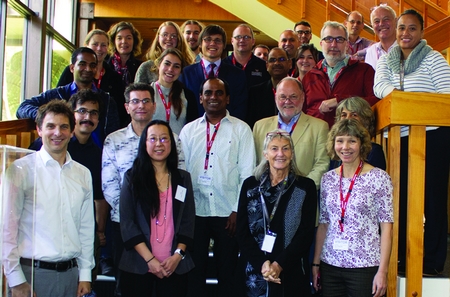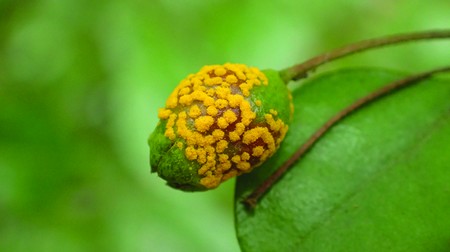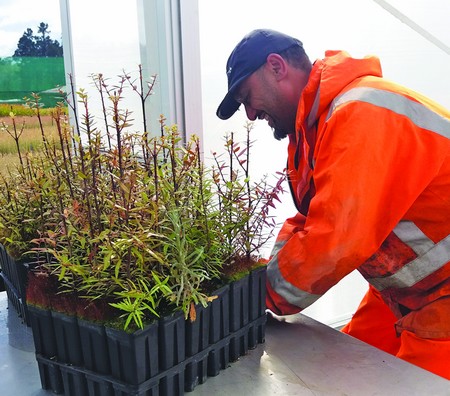Collaborating for impact
National Science Challenges
New Zealand’s National Science Challenges are tackling the big science-based issues and opportunities facing the country. Scientists involved report they have been challenged to work quite differently – to be collaborative, to work across disciplines and co-develop science with a broad range of stakeholders.
Scion scientists are working on six of the challenges, along with other top scientists from Crown research institutes, universities and other research bodies.
The Building Better Homes, Towns and Cities challenge aims to improve the quality and supply of housing and create smart and attractive urban environments. Scion is working with Toi Ohomai Institute of Technology on its Toitu te Kainga, Toitu te Ora, Toitu te Tangata (sustainable homes, healthy people) research project. Other partners and collaborators include the Matekuare Whanau Trust, Unitec Institute of Technology, and Tallwood (an Auckland-based design and prefabricated-construction company). The project aims to improve housing quality and functionality and thus the health and wellbeing of the Matekuare whanau.
Scion has modelled the heat and moisture flows in three case study buildings. An efficient thermal envelope helps create a healthy and comfortable home and reduces costs over a building’s lifetime. The results of the modelling are being incorporated into a concept building designed by Tallwood. The final design will be tested for buildability and ultimately constructed on site by the Matekuare Whanau Trust.
The Deep South Challenge aims to understand how New Zealand’s climate could change in the future and how this could affect key economic sectors including forestry infrastructure and natural resources.
Scion and researchers from Maanaki Whenua Landcare Research, MPI, University of Maine and He Oranga mo Nga Uri Tuku Iho Trust have modelled the potential impact of climate change on erosion and identified the optimal areas to be afforested to achieve erosion-reduction goals in Te Tairawhiti (East Coast). Their work showed that, over time, planting the right mix of tree species to sequester carbon and stabilise vulnerable land would bring environmental and economic benefits that would provide for future generations. It was also clear that climate change uncertainty, and its effects on future erosion patterns, need to be accounted for in policy making to ensure that public environmental investments such as the Erosion Control Funding Programme and Te Uru Rakau’s One Billion Trees Programme are successful.
New Zealand’s big high-tech challenges are being tackled by the Science for Technological Innovation (SfTI) challenge. Scion is leading the Spearhead project: Additive manufacturing and 3D and/or 4D printing of bio-composites in the materials, manufacturing and applications portfolio.
Additive manufacturing will harness New Zealand’s natural resources to create new, more environmentally friendly materials. Novel biopolymers and developing 3D and 4D printing technology has the potential to produce everything from architectural structures to furniture.
New Zealand is well-placed to play a leading role in the bioplastics revolution because of the numerous sustainable feedstocks available to us, including wood fibre, harakeke and by-products from primary industry. Our thriving manufacturing sector is also increasingly experimenting with 3D and 4D printing techniques to use natural polymers such as proteins, cellulose and lignin.
Scion is working with five New Zealand universities, AgReseach, GNS and industry. The team aims to have at least two 4D product prototypes ready to go by 2025 that support both the circular bioeconomy sector and the fast-growing Maori economy.

At the heart of Resilience to Nature’s Challenges is enhancing New Zealand’s ability to anticipate, adapt and thrive in the face of ever-changing natural hazards. The Scion-led project Resilience to Wildfire challenges involves Northland communities in wildfire-prone areas to develop risk awareness and a better understanding of Maori perspectives and practices for fire management.
Scion is also contributing to documenting and exploring the ways in which rural communities are recovering from the Kaikoura Earthquake. The insights from this work, not only with the communities but also transient populations like tourists and seasonal workers, have the potential to inform preparedness and resilience-building initiatives elsewhere in New Zealand.
Working with the High Impact Weather team and Heritage New Zealand, Scion researchers will be mapping severe projections such as tropical cyclone paths, and cultural heritage sites on the country’s landscape. The team will work with willing communities identified as highly vulnerable to future severe weather to enable them to plan, prepare and mitigate potential losses of heritage sites, homes and infrastructure. Ultimately, integrating local and traditional knowledge and values into improved natural hazard resilience strategies and solutions will benefit all New Zealand communities.
Protecting and managing New Zealand’s biodiversity through improving our biosecurity is the aim of New Zealand’s Biological Heritage challenge, as well as enhancing our resilience to harmful organisms. Scion is working collaboratively with other Crown research institutes, universities and others on several projects including combatting kauri dieback and myrtle rust, which is threatening indigenous plants, like ramarama, pohutukawa and manuka.
In a best-case scenario, pests would be stopped before they enter the country. A project led by post-doc fellow Rebecca Turner is using modelling and insect interception data to predict which insects are likely to invade next. Her research is partially funded by Te Punaha Matatini and the team includes researchers from Scion, B3 and the University of Canterbury.


International connections
Scion’s international reach is wide and deep, ranging from formal organisation-to-organisation agreements to scientist networks. Our scientists remain at the forefront of current knowledge, new approaches and technological advances through these collaborations and networks as the examples here show.
New biochemicals from lignin. Scion has a formal collaboration with VITO (Flemish Institute for Technological Research in Belgium) to accelerate the development of biochemicals from lignin. Lignin is a potentially rich source of aromatic chemicals currently derived from petrochemicals. As a first step, the lignin is broken into useful chemical building blocks. These need to be separated out and then rebuilt into new, high-value products.
Scion and VITO are each funding a postdoctoral fellowship following the very successful initial fellowship that was joint funded by the EU and The Flanders government. The new fellows began in January 2019 and will each spend time at both VITO and Scion continuing work on lignin processing and development of new compounds and products.
An annual face-to-face meeting is part of the Scion-VITO collaboration agreement. Scion hosted Walter Eevers, VITO Director of Research, in September 2018.
Creating new materials and products from bark. Bark biorefinery technologies provide a new economic opportunity to convert bark – an underutilised waste stream of around 2.3 million tonnes annually – into a range of high-value materials and products.
In a new five-year Scion-led bark biorefinery programme, supported by the Ministry of Business, Innovation and Employment’s Endeavour Fund, we are collaborating with VTT (Finland), Fraunhofer IGB (Germany), as well as the University of Lisbon ITQB NOVA (Portugal) and Auckland University of Technology. By 2023, we aim to have made crucial steps towards the development of a demonstration plant. The vision is for the biorefinery concept to be applied to many of New Zealand’s biomass streams with regions running their own biorefineries producing high-value environmentally friendly products. Both VTT and Fraunhofer have organisational collaboration agreements with Scion.
International Plant Phenotyping Network. Scion became a member of the International Plant Phenotyping Network (IPPN) in 2018. The IPPN is a global network with the aim of promoting joint science and research in plant phenotyping, increasing the visibility and impact of plant phenotyping and fostering communication between stakeholders and the public. Scion is to lead a global forest working group and will contribute to the development of remote phenotyping skills.
Working with Ellen MacArthur Foundation. The Ellen MacArthur Foundation is a UK-based charity that aims to build a positive future through the framework of a circular economy. The foundation co-hosted its first Pacific Summit with the Ministry for the Environment in partnership with Scion and Te Arawa in early April 2019.
The Ohanga Amiomio Pacific Summit was held at Te Puia in Rotorua and focused on the new approaches to a circular economy that could be unlocked when economics meets matauranga Maori and other indigenous worldviews. Korero on matauranga focused on shifting emphasis from caring about the environment, to caring for the environment, moving from a human-centric view point to one incorporating wairua and discussing if circular economy would be better described as a spiral economy with regeneration and growth.
Scion has long been promoting the benefits of a circular bioeconomy. A sign of our growing relationship with the Ellen MacArthur Foundation was the invitation to Dr Florian Graichen, Scion Science Leader Biopolymers and Chemicals, to present at the annual Ellen MacArthur Summit in London, June 2019.
Bioeconomy forums. Dr Elspeth MacRae is a member of the international advisory council for the Global Bioeconomy Summit 2020 (led by Germany) that is currently planning the 2020 meeting in Berlin. The EU-led International Bioeconomy Forum has also progressed its interest group activities. Scion, representing New Zealand, has joined Canada as co-chair of the forest working group. The Ministry of Business, Innovation and Employment is leading the precision in food activity, and New Zealand is participating in the microbiome activity (led by EU) and bioeconomy indicators group.
